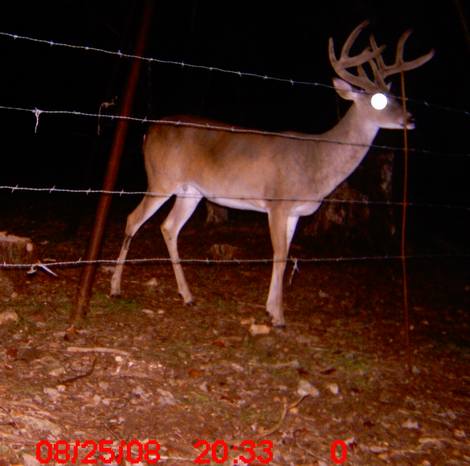With the fall deer hunting season just around the corner and thousands of game cameras attached to trees, posts, or anything else an ingenious hunter can mount a camera to, photos are constantly being taken of white-tailed bucks going through rapid antler transformations — from velvet covered antlers to fresh, clean racks. It really is amazing how fast antlers can grow, but just as amazing is how fast a buck can take it all off!
Last week we talked about how minerals are transported from a buck’s skeleton as its antlers grow, but this week we are are touching on the velvet removal process. Velvet is removed because testosterone levels of bucks rise during the fall triggering the mineralization of the cartilage-like tissue. Because a buck’s antlers are very tender during the velvet stage and they have low levels of testosterone, bucks are very friendly towards one another. In fact, you will rarely see bucks fighting at all during the antler growing period.
But don’t think they don’t fight. Bucks do fight, they just do not use their antlers. During the spring and summer, whitetail bucks often settle fights by threats and posturing, but when push comes to shove they fight much likes does — on their hind legs using their front legs to kick! But back to the mineralization of antlers.
Once antlers become totally mineralized, the blood vessels in the velvet surrounding them dies and begins to dry up. As the velvet begins to slough off bucks will aid the process by rubbing their antlers on nearby saplings and trees. Bucks will continue to rub their antlers on brush up until the rut as they work off building aggression and prepare for battle with other white-tailed bucks.
The photos below show a 9-point buck located in central Texas over about a week period. You can identify the buck as the same deer because of his short G4 on the right side, but you can see that this guy went from velvet to clean in short order. And just think, he will be shedding his antlers in about 5 months and starting all over, if he makes it through hunting season!




We have a small weekly newspaper in Rocksprings, Texas. Do you give permission to reprint your stories with credits given to you? I am interested in several. Thank you, Carolyn Anderson/Editor
What determines when a buck sheds his velvet? Does age have anything to do with when a buck sheds?
Jim, age does play a role to some extent because older deer tend to do everything first… start growing antlers, breeding, shedding antlers, etc. However, the nutritional status also plays a role. Deer in poor condition will shed antlers earlier and deer in good condition will shed later.
I read an article in bow and arrow magazine that said deer that rub trees to remove velvet is a myth and has nothing to do with the shedding process?
I’m sure that there is very big debate over this . In most all opinions, this statement is false: deer do not just drop there velvet. The process in velvet shedding is open to argument, but the reality is they do rub trees and bushes and such in order to relieve the dead tissue to expose the “hard horn” antler.
Travis, I think you are on the right track with your statement. Antler growth ceases because of hormonal changes. These changes not only stop antler growth, but cause the living “velvet” that nourishes the previously-growing antlers to die. Changes in hormones, or better stated, increases in testosterone levels, also cause bucks to fight trees and shrubs to relieve their building aggression. In the process, the velvet is removed from a buck’s antlers. This may have been confused above.
Technically, whitetail bucks do not rub off their velvet. It falls off. They may rub after the velvet falls off to harden the antler. Then later they rub to mark territories during the rut. The reason I know is because I have a friend that has a hunting ranch and have seen it happen first hand. They will actually shed the velvet in one day.